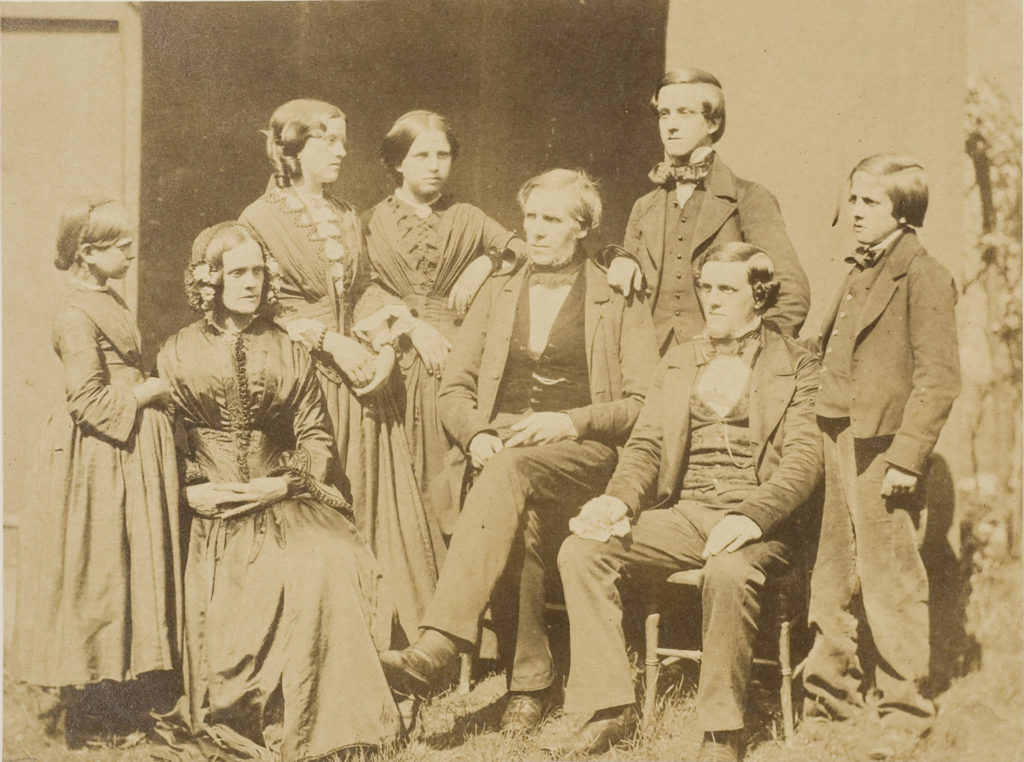What we see in this image
This unidentified albumen photoprint was taken from an album which bore the signature of public servant, author and painter John Rae, a self-taught early amateur colonial practitioner of collodion photography. The subjects of this unknown family portrait are posed, either seated or standing, in a domestic garden setting with the wall of a building and a plain dark drop sheet forming a backdrop. All appear to wear comfortable, well-worn clothing reflective of informal everyday dress in the mid-nineteenth century.
The family group is comprised of eight people (two parents and six children) from left to right:
a girl [aged 8], standing in right facing profile, wearing an ankle-length plain [cotton] day dress, the full skirt worn without petticoats and the fitted bodice with a closed neckline trimmed with a separate narrow white band collar, above a corsage of gathered pleats, fanning up from the waist over the shoulder, and 3/4 length pagoda sleeves with a fitted sleeve head worn without undersleeves;
a mother, seated on the left, wearing a plain silk/sateen day dress with an unornamented full skirt worn with minimal petticoats, and an open bodice with a fan front rising from a deeply pointed waistline, trimmed with looped passementrie braid which also trims the edges of her full length ‘pagoda’ sleeves, worn with closed undersleeves of matching fabric gathered into a cuff at the wrist, her lace-edged collar fastened at the neckline with a gold brooch. She wears her centre-parted hair with a side curl over each ear, anchored at the temples with barrettes, the crown of her head covered with a [mesh cap] trimmed with artificial flowers;
two older (teenage) daughters, standing behind their parents, one leaning left arm on father’s left shoulder, both wearing similar styles of plain [cotton] day dress with bodices gathered into pointed waists and fan fronts trimmed with scalloped and Vandyked edges respectively, opening over either a white or self-fabric chemisette, closed at the neck with a ribbon tie or white collar band fastened with a brooch, their 3/4 length pagoda sleeves worn with and without undersleeves above bead or [seed] bracelets (possibly homemade). The girls have also chosen slightly different hair styles, one with waved sections of hair laid over the temples above a pair sausage curls, the other following the popular bandeau style of wrapping smooth sections of hair over her ears and drawn back to the nape of the neck;
a father, seated at centre, with an older (teenage) son, standing behind leaning his right arm on his father’s right shoulder, the eldest son seated on his father’s right, and the youngest son [aged 10] standing in left facing profile, wearing a type of short jacket, cut along the line of female fashions, reserved for juveniles under the age of 12. The other male members of the family wear an array of single-breasted, narrow-sleeved woollen jackets and trousers over white shirts with pointed collars, individualised by their choice of waistcoat (either in velvet, brocade or cloth) and neck cloths or silk bow ties of varying magnitude and stylishness. The two older men wear square-toed, elastic-sided leather boots and display their fob chains, anchoring pocket watches, draped across their torsos. All wear their hair with low right hand partings.
What we know about this image
John Rae (1813-1900) migrated to Australia from Scotland in 1839 to work in Sydney. By 1843, he had been appointed Sydney’s first Town Clerk and later occupied in various public works positions. He was also a talented amateur artist, painting watercolours of Sydney streets and making a camera obscura to contribute to his panorama of Sydney Harbour – perhaps his best-known work is his 1850 watercolour of the turning of the first sod for the first railway. In the 1850s Rae became interested in, and taught himself photography, initially to record details for later paintings. In September 1855 he gave two lectures on the subject of photography at the Sydney Mechanics School of Arts, subsequently excerpted in the Sydney Morning Herald (see 14/9/1855, p.8; 21/9/1855, p.2.) encouraging other amateurs to take up collodion work.
MLMSS 6998: John Rae – Letterbook, 1840-1854
In these letters Rae writes about his personal affairs, his lectures at the Sydney Mechanics’ School of Arts, and his experiments with various photographic techniques. There are also sketches by Rae of the camera he designed (p.678).
Print page or save as a PDF
Hover on image to zoom in

1856 – Unidentified family group
Open in State Library of NSW catalogue
Download Image
| Creator |
| [Rae, John] |
| Inscription |
| To follow |
| Medium |
| Photograph |
| Background |
| Removed from album with John Rae’s signature. See also: P1 / 2039: a4447039 |
| Reference |
| To Follow |